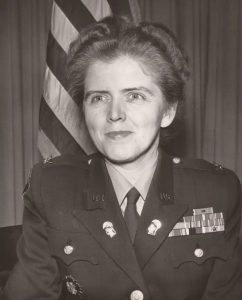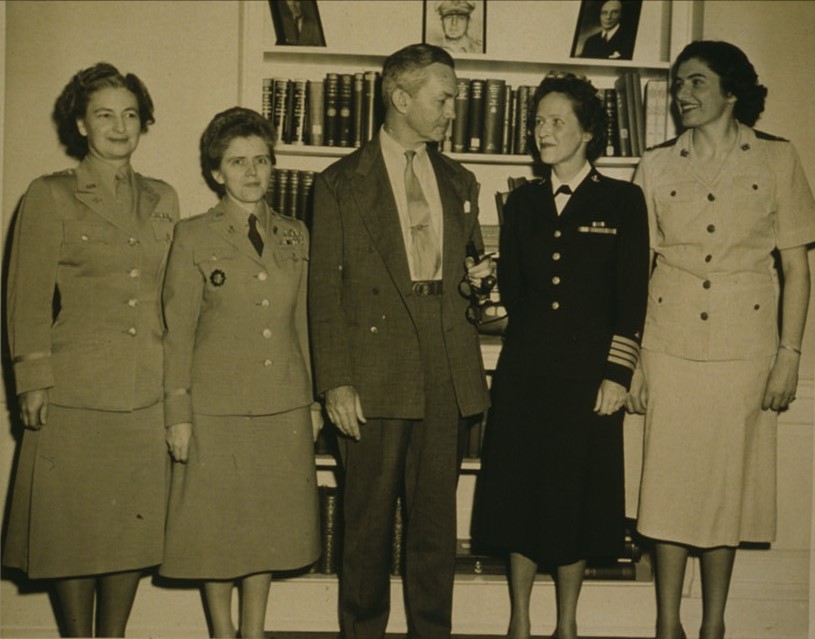Mary A. Hallaren
Colonel
Women’s Army Corps
May 4, 1907 – February 13, 2005

Col. Mary Hallaren, unknown date. Public Domain
Mary Hallaren, the third director of the Women’s Army Corps (WAC), volunteered for the Women’s Army Auxiliary Corps in 1942 and remained through the transition to WAC in 1943. She was one of the most vocal advocates for women to hold permanent military status in the U.S. Armed Forces after World War II. Her contributions for women in the military inspired others to follow in her footsteps.
Mary Agnes Hallaren was born in 1907 in Lowell, Massachusetts. She graduated from Boston University and Lowell State Teachers College (now the University of Massachusetts Lowell). After graduating, she taught junior high school for 15 years in Lexington, Massachusetts, spending her summers traveling throughout the United States, Mexico, Canada, and Europe.
Although her specific motivations for joining the military are unknown, when asked by a recruiter how someone of her size could help the army (she barely stood five feet tall), she countered by saying, “You don’t have to be six feet tall to have a brain that works.” In 1942, she enlisted in the Women’s Army Auxiliary Corps (WAAC) and was one of the first women selected for Officer Candidate School. Upon graduation in 1943, she was appointed as an executive officer. Captain Hallaren’s first assignment was as the commanding officer for the 1st WAAC Separate Battalion, becoming the first WAAC to serve in the European Theater of Operations in World War II. She rose further in rank to serve as a staff adviser for all Women’s Army Corps in Europe from 1945 to 1946.
Legislation for a women’s Army corps was first proposed by Congresswoman Edith Nourse Rogers in May 1941. She was unable to gain support in Congress until the Japanese attack on Pearl Harbor, when the U.S. Army identified a manpower shortage. However, resistance to women in the Army persisted. Finally, in May 1942, President Franklin D. Roosevelt signed the bill to create an auxiliary corps. This new corps would relieve men of non-combat positions so they could be deployed for overseas missions. As auxiliary members of the Army, the WAACs did not fall under Army regulations, leaving them without many of the same benefits or legal protections of male Soldiers. To fix this problem, the Women’s Army Corps (WAC) was formed in 1943. As a WAC, these women achieved full military status within the Army. Now the women would be governed by the same Army regulations and command structures as their male counterparts. However, many in leadership believed that the WAC should not be permanent, and instead should be disbanded at the end of World War II. This solution did not satisfy Hallaren, however, and she worked to ensure women could serve as permanent members in all branches of the U.S. Armed Forces.
Hallaren first briefly served as deputy director, then became third director of the Women’s Army Corps in 1947. She supervised the first WAC training programs at Fort Lee, Virginia (now Fort Gregg-Adams), and the integration of women into the Army and Army Reserve. She was integral in the passing of the Women’s Armed Services Integration Act, especially when the subcommittee postponed hearings in 1947 and WACs considered leaving the service for civilian life. Hallaren challenged these active-duty WACs to remain in the corps, noting, “Breaking the trail has always been harder than following it.” She even testified before Congress along other notable political figures, including General Dwight D. Eisenhower. Her hard work paid off in 1948 when the Women’s Armed Services Integration Act finally passed, making women permanent, regular members of the U.S. Armed Forces. The battle to serve in combat positions persisted for decades, but this was a big step for the future of women in the military.

Secretary of Defense James Forrestal (center) congratulates (left to right) Colonels Geraldine May and Mary A. Hallaren of the U.S. Army, Capt. Joy Bright Hancock of the U.S. Navy, and Maj. Julia E. Hamblet of the U.S. Marine Corps, after the passage of the Women’s Armed Services Integration Act. 1948. Cropped. U.S. Army Signal Corps
In 1950, she led efforts to expand the numbers of WACs in the Korean War. She also directed a commission program for WAC officers, assisted with uniform development, and gained congressional approval for funds to create a new training facility and base at Fort McClellan, Alabama. In 1953, she stepped down from her director position and reverted to the rank of lieutenant colonel, which was required by law at the time. From there, she served four years in the Headquarters of the U.S. European Command in Frankfurt, Germany. She went on to work as an operations officer in the Office of the Assistant Secretary of Defense of Personnel and Reserve Affairs from 1957 to 1960. Hallaren officially retired on June 30, 1960.
Back in civilian life, Mary completed an additional bachelor’s degree from George Washington University. She later joined the U.S. Department of Labor as executive director of Women in Community Service (WICS), a position she held for 13 years. She served as a consultant for the organization following her retirement. Hallaren remained linked to her past military career and served on the WAC Foundation Board of Directors. She continued to advocate for women in the U.S. Armed Forces, speaking at various public venues about women’s contribution to national defense and other matters. In 1990, she advocated specifically for the Women in Military Service for America Memorial at Arlington National Cemetery (now the Military Women’s Memorial). An avid traveler from her days as a teacher, she continued this hobby throughout her life, taking a trip with WICS to China at 92 years old.
Hallaren received a litany of awards for her achievements in the Army, including the Third Legion of Merit award for dedicated military service, a Bronze Star with one Cluster, the WAAC Service Medal, a WWII Victory Medal, and a National Defense Medal. She was inducted into the National Women’s Hall of Fame in 1996. Hallaren died on February 13, 2005, in McLean, Virginia. Her legacy as an advocate for women in the Armed Forces left a lasting impact on the women who served in her company as well as those who served long after she was gone.
Carly Herrud
Graduate Historic Research Intern
Sources
Brokaw, Tom. The Greatest Generation. New York: Random House, 1998.
“Colonel Mary A. Hallaren.” Women’s International Center. Accessed December 19, 2022. http://www.wic.org/bio/mhallare.htm.
Holm, Jeanne. Women in the Military : an Unfinished Revolution. Rev. ed. Novato, CA: Presidio Press, 1992.
Monahan, Evelyn, and Rosemary Neidel-Greenlee. A Few Good Women: America’s Military Women from World War I to the Wars in Iraq and Afghanistan. 1st ed. New York: Alfred A. Knopf, 2010.
Morden, Bettie J. The Women’s Army Corps, 1945-1978. Washington, D.C: Center of Military History, United States Army, 1990.
Permeswaran, Yashila. “The Women’s Army Auxiliary Corps: A Compromise to Overcome the Conflict of Women Serving in the Army.” The History Teacher 42, no. 1 (2008): 95–111.
Roth, Tanya L. “Hallaren, Mary (1907–2005).” In An Encyclopedia of American Women at War: From the Home Front to the Battlefields, edited by Lisa Tendrich Frank, 268-270. Vol. 1. Santa Barbara, CA: ABC-CLIO, 2013. Accessed November 14, 2022.
Treadwell, Mattie E. The Women’s Army Corps. Washington, D.C: Center of Military History, United States Army, 1991.
Schudel, Matt. “Col. Mary Hallaren, 97, Dies; Headed Women’s Army Corps.” Washington Post, Mar 04, 2005. Accessed November 14, 2022.
“4,000 WACS Abroad and ‘They Love It’.” New York Times, Aug 17, 1952. Accessed November 14, 2022.
“Senators Approve Women Army Corps: Military Committee Reports House Bill for Auxiliary to Serve with the Military.” New York Times, May 9, 1942. Accessed November 14, 2022.
Additional Resources
United States Army Women’s Museum at Fort Gregg-Adams.
Bonnell, Françoise Barnes, Ronald Kevin Bullis, and Charlotte T. McGraw. Capturing the Women’s Army Corps: the World War II Photographs of Captain Charlotte T. McGraw. Albuquerque: University of New Mexico Press, 2013.
